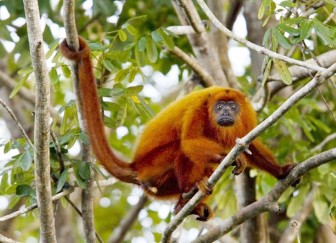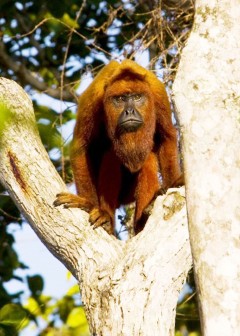It’s 4 am in the rainforest and you are awakened by the sound of loud eerie roaring; if you are new to the environment it can be a disconcerting sound. This is the call of the Red Howler Monkey (Alouatta seniculus) sounding out its location to other family groups. Howlers, or “baboons” as they are locally known, call early in the mornings and at the close of the day to let each group know where their territories are. When one group calls the others answer helping them to avoid direct contact. Known as the loudest of all monkeys the Howler’s call can be heard from over 3 miles away. Howler monkeys have large throats and specialized voice boxes that give them the ability to call loudly through the rain forest.
Red Howler Monkeys are easily recognised by their goldish red coat. The males are slightly larger than the females. Howler monkeys range in size from 22 to 36 inches in head and body length, with tails that are 23 to 36 inches long. They weigh from 15 to 22 pounds. Howler monkeys have prehensile tails, or tails that can grip. The monkeys would use their tails as a fifth limb to grip branches. While the Howler’s tail is strong enough to hold its body weight, unlike the Spider Monkey, the animal rarely hangs from branches using its tail.
![]() Red Howler Monkeys live in groups called troops. They spend most of their time in the mid to upper levels of the canopy. During the dry season they may come to the ground at the river’s edge to drink and eat earth for minerals. They are also known to use salt licks. Howlers are mainly vegetarians and feed on leaves, as well as fruits, nuts, and flowers. They spend very little time moving around and therefore have small home ranges. They spend each day feeding leisurely at the very top of the forest canopy and sunbathing to assist their vegetable diet to digest. They’re usually hard to spot from the ground, but can be seen quite easily from the river sitting in high riverside trees. When alarmed Howler Monkeys may position themselves to defecate or urinate on the person below.
Red Howler Monkeys live in groups called troops. They spend most of their time in the mid to upper levels of the canopy. During the dry season they may come to the ground at the river’s edge to drink and eat earth for minerals. They are also known to use salt licks. Howlers are mainly vegetarians and feed on leaves, as well as fruits, nuts, and flowers. They spend very little time moving around and therefore have small home ranges. They spend each day feeding leisurely at the very top of the forest canopy and sunbathing to assist their vegetable diet to digest. They’re usually hard to spot from the ground, but can be seen quite easily from the river sitting in high riverside trees. When alarmed Howler Monkeys may position themselves to defecate or urinate on the person below.

These monkeys live in family groups made up of males, females, and young. The number in the group varies, but a troop is generally made up of 5 – 9 individuals. As they move from tree to tree, they stick together as a family. The leader is usually an old male. Wild howler monkeys live, on average, 15 to 20 years. In captivity they have lived pass 22 years but they are usually difficult to keep. Howlers only have one offspring at a time. The female gestates for 6 months. The infant will stay with the mother between 1.5 – 2 years. Males on reaching maturity are usually expelled from the group and have to invade another group to mate. The species is preyed on by the Harpy Eagle.

Rain forests are rich in biodiversity and are home to many different plants and animals. In addition, indigenous communities make their homes there. Even if you don’t live in the rain forest, humans rely on the forest for resources such as building materials (wood and lianas), medicine and fruits. Rain forests also provide essential environmental services for life on earth; they create soil as well as prevent soil erosion, produce oxygen though photosynthesis, maintain clean water systems, and are a key defence against climate change.
The Iwokrama Rain Forest is 371,000 hectares, located in the heart of Guyana. Our mission is to develop strategies for conservation and sustainable development for local people in Guyana and the world at large. We are involved in tourism, training, research and our timber is certified by the Forest Stewardship Council. Come and visit us in the rain forest or at http://www.iwokrama.org.










